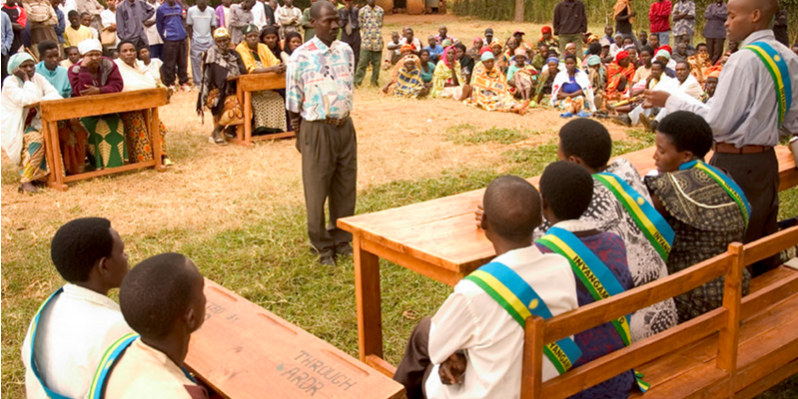On 6th April 1994, within the context of an already brutal civil war, a plane carrying Rwandan President Habyarimana, a Hutu, was shot down, and all those onboard killed. The response of Hutu extremists to the assassination was a fierce campaign of revenge. The following 100 days saw the slaughter of between 800,000 and 1 million Tutsis and moderate Hutus by organised gangs of soldiers, the Interahamwe, militias and Hutu civilians and the perpetration of sexual violence on an industrial scale.
In July, the Tutsi Rwandan Patriotic Front (RPF), led by Paul Kagame, took control of Kigali, declaring a de facto ceasefire and an end to the violence. Tutsi troops continued to attack and massacre Hutu civilians, however, and on 27th September the UN’s Human Rights Commission estimated that as many as 30,000 Hutus had been killed since the RPF took control.
The sheer scale of atrocities committed during the genocide by so many people posed enormous challenges for the country’s justice system, a problem that was exacerbated by the fact that much of the country’s infrastructure had been destroyed and many legal and judicial staff killed. By the turn of the century over 100,000 people had been arrested and were being held in severely overcrowded prisons.
Rwanda’s approach was both ambitious and novel, relying on a combination of conventional and traditional mechanisms: the domestic criminal courts, the gacaca system and the UN’s International Criminal Tribunal for Rwanda (ICTR).
The results have inevitably been mixed. The criminal justice system in Rwanda remains under-resourced to this day, with insufficient numbers of judges, prosecutors, legal representatives, and interpreters resulting in significant delays to judicial proceedings. The right to legal representation is guaranteed in law, although in practice the cost of hiring a lawyer is prohibitive for some, and many lawyers are reluctant to act in politically sensitive cases for fear of harassment and threats from government officials. The gacaca courts succeeded in hearing 1.9 million cases and worked quickly, and their truth-seeking remit likely elicited information that led to the identification of mass grave locations, although the extent to which confession evidence was complete in terms of the details and facts offered is doubtful given the ongoing discovery of mass graves. Reparations have been largely inadequate, although the provision of rehabilitative services at the gacaca was seen by many survivors as a positive and necessary measure. Compensation, however, was seldom awarded by the gacaca, as many perpetrators were indigent. And while the ICTR provided an international focus and spotlight on the atrocities, its limited capacity meant that it heard relatively few cases, and within the survivor community has been criticised as being geographically and conceptually isolated and divorced from the realities of Rwandan life. In all three cases, survivors of sexual violence have struggled to be heard.
The system of collective memorialisation – an understandable approach given the huge number of victims involved and the significant challenges that individual identification and repatriation would entail – has also meant that for many survivors they will never know where their loved ones are or what happened to them. Commemorative events have enabled a degree of survivor narrative and truth telling, although again in practice favours male survivors.
Significantly, there is a clear difference in justice experiences between Tutsi and Hutu victims, both domestically and internationally, and for Hutu victims of RPF violations justice remains illusory. Much of the State criminal justice machinery is limited in remit to crimes committed against the Tutsi during the genocide, and while the remit of the ICTR was broader, in practice it only heard cases involving crimes against the Tutsi. Oversight of RPF crimes was also removed from the remit of the gacaca, and the practice of collective memorialisation has the effect of subsuming Hutu victims within the wider Tutsi genocide narrative.
Despite the challenges, accountability for perpetrators of the genocide in Rwanda remains a live issue and Rwanda is actively searching for individuals who are suspected of involvement in the genocide and continues to seek assistance from other countries where suspects are believed to have fled. Mass graves are still being discovered and exhumed, including in circumstances where housing has been built over them. But time is passing, memories are fading and perpetrators are dying before they can be brought to justice.
Dr Ellie Smith







